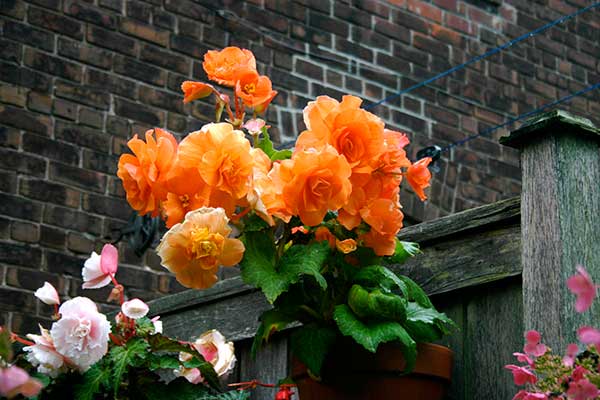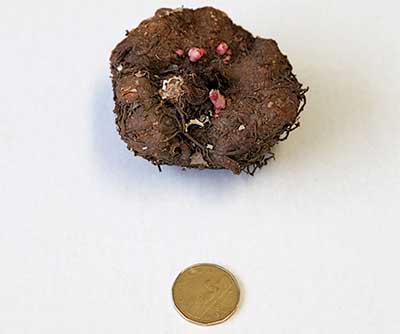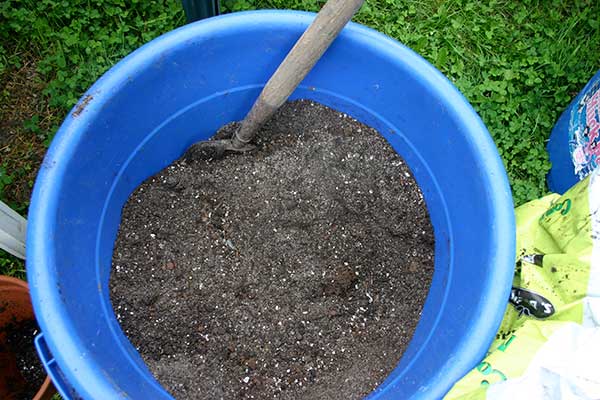
When you consider that tuberous begonias can flower continuously from June until frost, have blooms that last more than a week, are easy to grow, and come in just about every colour, it’s a wonder more gardeners don’t grow them.
If this is your year to try growing tuberous begonias, now is the time to get them started.
Bulb basics
The neat thing about any flower bulb is that it’s a complete flowering kit with food and flower in a durable package (bulb). This food can be delicious, and if you have any bulbs like potatoes, onions, garlic or ginger root, you know what I mean. The begonias we’re discussing grow from concave-shaped tubers. They like a barely moist soil and bright, dappled shade.

Since tuberous begonias flower non-stop, the sooner you get them going, the sooner (and longer) they’ll start blooming. Use shallow trays or pots, and plant the tubers concave side up in well-draining potting soil. Cover the bulbs with no more than one-half inch (1 cm) of soil.

Begonia tubers can take awhile to wake up from their winter dormancy, so be patient (an essential virtue every gardener needs). Once they’ve produced leaves, you can transfer them to their final containers.
The minimum pot size for a single tuber is six inches (15 cm) in diameter or three in a 12-inch (30-cm) pot. Some of you may want to plant them directly in the garden, which is fine provided you remember to lift them and bring them indoors before a hard frost. It’s simpler to pot them in terra-cotta pots and plunge the pots in your flower beds, lifting them — pot and all — before winter. Tubers can last for many years if you overwinter them indoors.
Tuberous begonias hate heat, so place them in bright, dappled shade, in morning sun or anywhere where they won’t get baked by midday sun. Their fleshy stems can be fragile in the wind.
Soil for potted bulbs
Why buy potting soil when you can make your own? I mix equal parts peat moss (or coir), well-rotted manure and coarse sand (the kind used to make cement). This provides the food, moisture retention and drainage summer-flowering bulbs like. You’ll know if your bulb is happy if it’s larger at the end of the season than it was at the start.


I have started my tubers and moves them to a sunny window. They are becoming leggy. Is it alright to pinch them???
It’s hard to tell without seeing your plant, but there are many members of the large begonia family that don’t grow from tubers. These are best propagated from cuttings taken during the summer and overwintered as young plants indoors.
We lifted our begonias today and they didn’t appear to have tubers just roots. Are they a different variety? They were large showy ones and were pendular. Does that mean we cannot store them over winter? Jennifer
Hi Dugald,
I have a tuberous begonia that I bought from you several years ago. I overwinter it in peat in a dry dark cupboard. This year I planted it in the same pot as usual, in the same place as usual..but it hasn’t flowered. I haven’t fertilized this year…could this be the reason that it hasn’t flowered for the first year ever? My agapanthuses (which I also bought from you) haven’t flowered either. I gave them slow-release tomato fertiliser.
Hoping that all is well with you!
Dianne Pettigrew
Hi Dianne:
My rule of thumb for all summer flowering bulbs like Begonias is that if your bulb/tuber/corm is bigger at the end of the season then you’re providing the right conditions. Lack of feeding my well be the problem (they should be fed), but its a good idea to ask yourself “what has changed since last year”? Light levels, soil, water, temperatures and length of season can all affect flowering. Give your Begonia some fresh soil next year and add some slow release fertilizer.
I have more questions than answers regarding your Agapanthus. Is it in full sun? Has it grown larger? How large is the pot you’re growing it in? The fertilizer they love best has an NPK ratio of 1:2:4. Tomato fertilizer is close enough to work so I don’t think that’s the problem. If it’s growing well than I suspect your problem may be overwintering temperatures. Agapanthus form next summer’s flowers during their winter dormancy. They want to be in a COLD, dark place over winter. By cold I mean above freezing but BELOW 8C. If it’s too warm it won’t be able to form the flower buds.
Thank you, Dugold. A propos the Agapanthus, I’ve kept it in the garage for years, where it doesn’t freeze. However, we have a window in the garage, so I’ll make sure that it’s well away from that this winter. The begonia has JUST started to flower. I plant it in fresh soil each year, but will make sure to fertilize it next year. Maybe I’ll start it indoors too next year. It went out really late this year due to weather conditions.
Agapanthus need cold 8C winter followed by a long, warm summer and frequent feeding. Chances are one of these requirements was lacking. I suspect our long cold spring have delayed their bloom. I always start mine indoors to extend their bloom.
Glad to come across this advice about agapanthus. Mine has leaves that come back faithfully every year but it never flowers although it receives fill sun. I’ll check the temperature next overwintering because I think that part of the basement I leave them is might be too warm. Thanks!